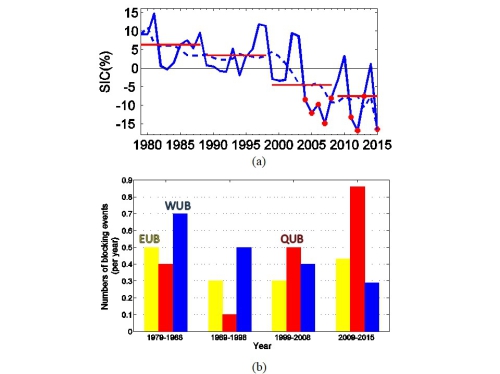In recent two decades, the variability and impact of the Arctic sea ice extent has been a hot topic because changes in atmospheric circulations, winter extreme cold events, habitat ecosystems and ocean circulation were shown to be linked to the Arctic sea ice change. Although the Arctic sea ice extent is influenced by atmospheric circulation patterns, it is unclear how the atmospheric circulation affects the Arctic sea ice variability. A recent study published in J. Climate suggested that the movement of Ural blocking has an important effect on the Arctic sea ice extent.
By classifying UB into quasi-stationary (QUB), eastward-shifted (EUB) and westward-shifted (WUB) UB types, Prof. LUO Dehai and his Ph.D. student CHEN Xiaodan from the Institute of Atmospheric Physics at Chinese Academy of Sciences through a cooperation with Profs. Steven Feldstein and Sukyoung Lee from Penn State University, found that the QUB related to lesser prior sea ice decline in Barents-Kara Seas (BKS) is able to lead to a largest sea ice decline in the BKS compared to other types and the sea ice decline lags the QUB peak by about 3 days. However, the overall effect of the WUB is to lead to an increase in the BKS sea ice during its life cycle. Thus, there is a positive (negative) feedback between the BKS sea ice decline and QUB (WUB).

Figure. Time series of (a) DJF-mean sea ice concentration averaged over Barents-Kara Seas (BKS) and (b) blocking frequency of quasi-stationary (QUB, red), eastward-shifted (EUB, yellow) and westward-shifted (WUB) Ural blocking events in winter.
Further calculations reveals that the downward infrared radiation (IR) related to QUB plays a main role in driving sea ice decline, but for EUB downward IR and sensible heat fluxes have comparable contributions to the sea ice loss. While the WUB leads to a decline in sea ice during its growth phase, it results in a rise of the BKS sea ice because downward IR and sensible heat fluxes become persistently negative during its decay phase.
"The increased frequency of quasi-stationary UB events observed during 1999-2015 can, to a large extent, explain why the decline of the winter BKS sea ice is accelerated during 1999-2015, though they are coupled together” said Prof. Luo."the QUB requires in fact a lesser prior sea ice extent and it subsequently amplifies the BKS sea ice decline."
Reference:
Chen, X., D. Luo, S.B. Feldstein, and S. Lee, 2018: Impact of Winter Ural Blocking on Arctic Sea Ice: Short-Time Variability. J. Climate, 31, 2267–2282, https://doi.org/10.1175/JCLI-D-17-0194.1
Contact: Ms. LIN Zheng, jennylin@mail.iap.ac.cn